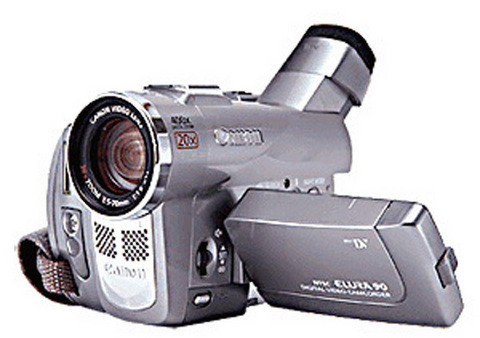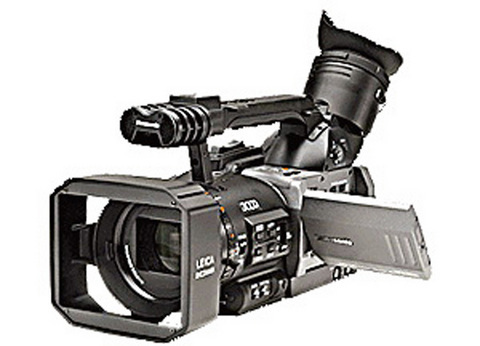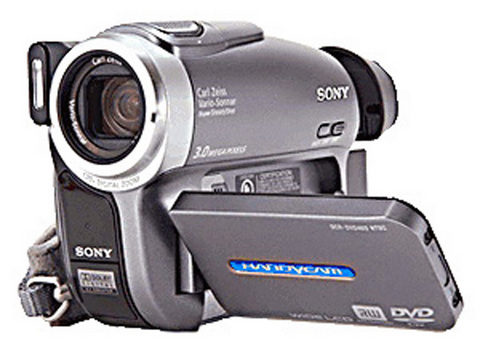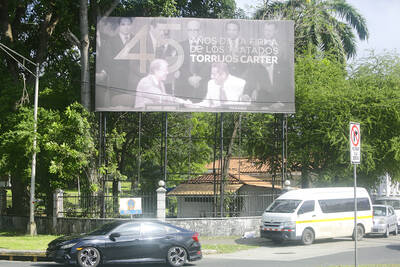A number of things have happened in recent years to make recording digital video an easier and more affordable prospect. Not only have camcorders become less expensive, increased bandwidth and larger computer memory space have made it possible to include digital video in business presentations, on a Web site, and even in e-mails to the family.
Additionally, the range of recorders has evolved in step with the increased number of applications for video. Where once only a small range of suitcase-sized recorders were available, and only for those with suitcases of cash, today's buyer can get a near pocket-sized recorder for... well, a pocket full of cash.
With several good to great models from which to choose, finding which video recorder is right for you is more a matter of knowing what you want to do with it. So rather than look at specific models, we'll look here at some of the things to keep in mind when you start shopping.

PHOTOS COURTESY OF THE MANUFACTURER
Bells and whistles aside, a camcorder's ability to produce a great image is based in large part on the size and quantity of the charge-coupled devices, or CCDs it employs. CCDs work like the retina of your eye by converting light into information. In the case of a CCD, that information is a digitized image. Budget camcorders will more than likely have a single CCD maybe a quarter inch in size. Professional or so-called prosumer models might have three CCDs of up to one-third inch each.
Just because a recorder has only one CCD doesn't mean it's of poor quality; there are plenty of good machines on the market that have a single, albeit large, CCD.
Though this information usually isn't written on the package nor on the camera case itself, it is singularly important to the machine's ability to produce a good image. If the sales representative you ask doesn't know, he or she isn't going to be of real help to you. Shop elsewhere or, better yet, do your initial research on the Internet before ever heading to the store.

The quantity and size of a camera's CCD(s) will directly effect something else you may have never heard of that is nonetheless crucial to image quality: lux.
Lux is the international standard of luminance and is equal to one lumen per square meter. To which you say, "Right. What's a lumen?" As the answer involves things like steradians, candelas, and a lot of physics flimflam, best to suffice with the rule of thumb: the lower the lux rating, the better the camera can see in the dark.
Filming in dim light may not sound so important but bear in mind that admittedly unscientific studies suggest camcorders are more likely to come out in the evening and after a few drinks than any other time of the day. Recording in these conditions with a camera that has a lux rating of, say, eight, will result in colors that streak and images that ghost -- much the same as you saw it after your few drinks. A camera with a lux rating of two will produce much clearer images and have your friends thinking you're a sober and serious videographer.

Light sensitivity can also be determined, in part, by looking at the lens' aperture. A maximum aperture of f1.4 or f1.6 is best for low-light conditions.
Another aspect of camcorder technology that is often overlooked by buyers is sound. Often, machines can produce crystal clear images that make people look great but they're incomprehensible when they open their mouth. Background noise, a poor microphone or even motor hum from the camera itself can detract from sound quality. A couple of things to look for are a front-mounted microphone that will pick up the person in the frame, not the mumblings of the person holding the camera, or worse, the sound of them holding it! Also, if a camera has a zoom lens make sure it also has a "zoom" microphone, a common feature on many models -- but not all.
Barring good built-in sound equipment, look to see if your camera has the ability to add pro equipment, such as a hot shoe for a boom microphone or jacks for audio recording or dubbing equipment. And though it might make you look like a geek, it's rather important to check your sound levels with a pair of headphones or earbuds while you're filming, making any necessary adjustments, rather than get home to find your great-looking footage is inaudible.
Once you have your great-looking and great-sounding video "in the can," you'll likely want to move it to the box; either your television or computer. With the majority of today's camcorders shooting to Mini-DV this is easily done. And it's made even easier if your computer has Firewire capability. If it doesn't, getting a Firewire card will be worth your while given that, without it, moving hours of footage to your hard drive could take several more hours of waiting.
(A note on video storage: an increasing number of cameras are employing two types of storage, usually Mini-DV and one or another type of memory stick. This is because most carriers of camcorders want to be able to shoot still images that look as if they were taken with a digital still camera.) Traditionally, they didn't take these types of photos well.
And since many models use memory sticks or flash memory cards of a gigabyte or more, they can also hold several minutes of video that is also easily transferred from the camera to the computer. For this reason, you may want to look for models that are able to record video in more than format. Footage shot to Mini-DV can be several hours long and easily edited with most computer video software, whereas flash memory is great for shooting short video clips in .mpg, .wmv, or Quicktime format for attaching to e-mails or posting on your Web site.

April 14 to April 20 In March 1947, Sising Katadrepan urged the government to drop the “high mountain people” (高山族) designation for Indigenous Taiwanese and refer to them as “Taiwan people” (台灣族). He considered the term derogatory, arguing that it made them sound like animals. The Taiwan Provincial Government agreed to stop using the term, stating that Indigenous Taiwanese suffered all sorts of discrimination and oppression under the Japanese and were forced to live in the mountains as outsiders to society. Now, under the new regime, they would be seen as equals, thus they should be henceforth

Last week, the the National Immigration Agency (NIA) told the legislature that more than 10,000 naturalized Taiwanese citizens from the People’s Republic of China (PRC) risked having their citizenship revoked if they failed to provide proof that they had renounced their Chinese household registration within the next three months. Renunciation is required under the Act Governing Relations Between the People of the Taiwan Area and the Mainland Area (臺灣地區與大陸地區人民關係條例), as amended in 2004, though it was only a legal requirement after 2000. Prior to that, it had been only an administrative requirement since the Nationality Act (國籍法) was established in

Three big changes have transformed the landscape of Taiwan’s local patronage factions: Increasing Democratic Progressive Party (DPP) involvement, rising new factions and the Chinese Nationalist Party’s (KMT) significantly weakened control. GREEN FACTIONS It is said that “south of the Zhuoshui River (濁水溪), there is no blue-green divide,” meaning that from Yunlin County south there is no difference between KMT and DPP politicians. This is not always true, but there is more than a grain of truth to it. Traditionally, DPP factions are viewed as national entities, with their primary function to secure plum positions in the party and government. This is not unusual

US President Donald Trump’s bid to take back control of the Panama Canal has put his counterpart Jose Raul Mulino in a difficult position and revived fears in the Central American country that US military bases will return. After Trump vowed to reclaim the interoceanic waterway from Chinese influence, US Defense Secretary Pete Hegseth signed an agreement with the Mulino administration last week for the US to deploy troops in areas adjacent to the canal. For more than two decades, after handing over control of the strategically vital waterway to Panama in 1999 and dismantling the bases that protected it, Washington has